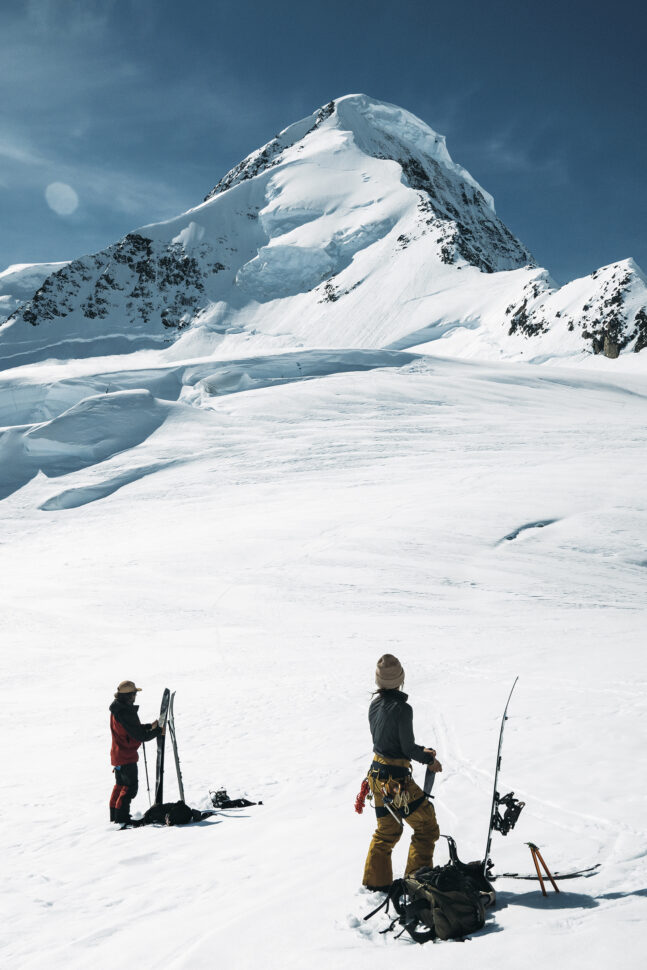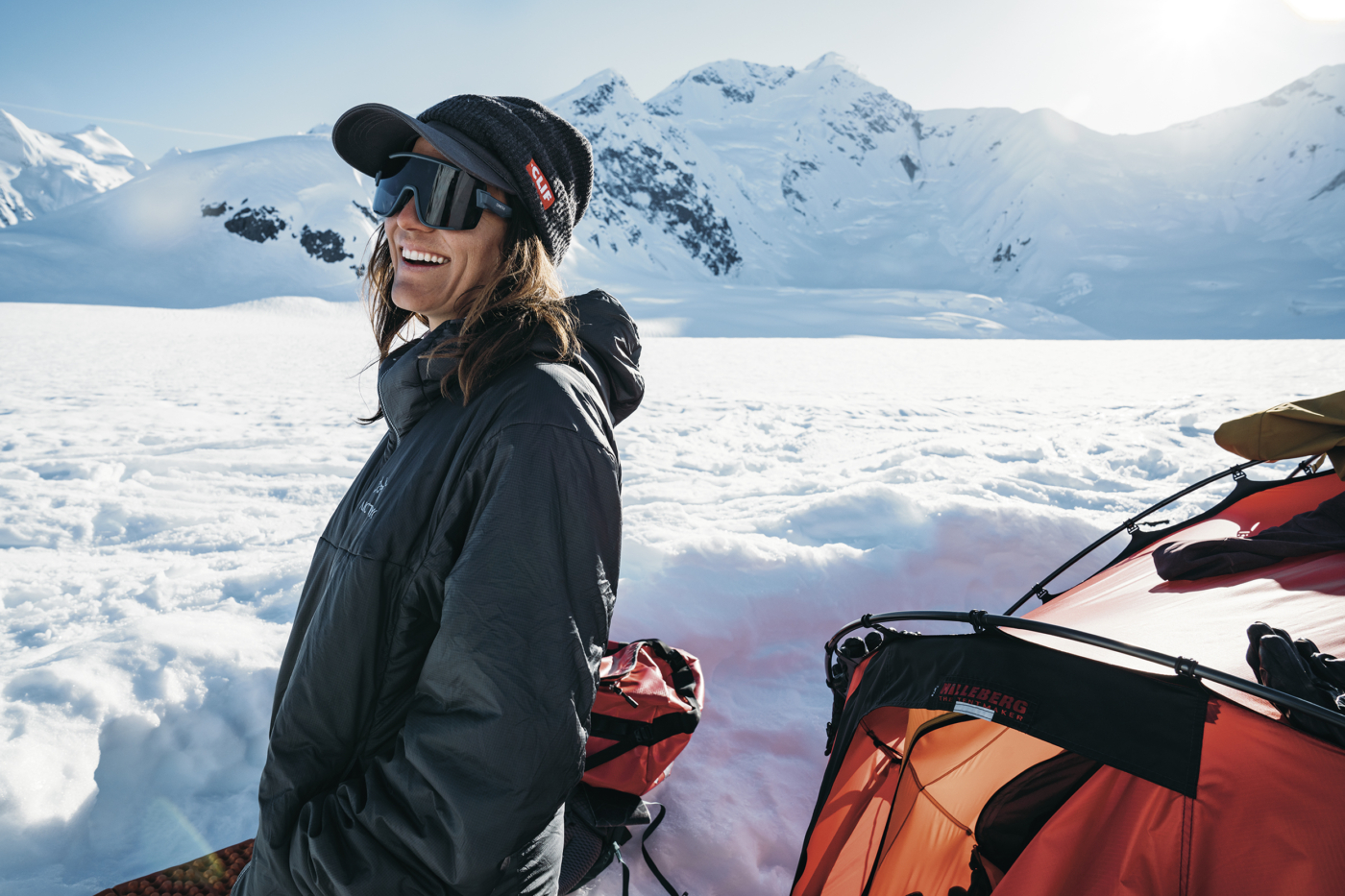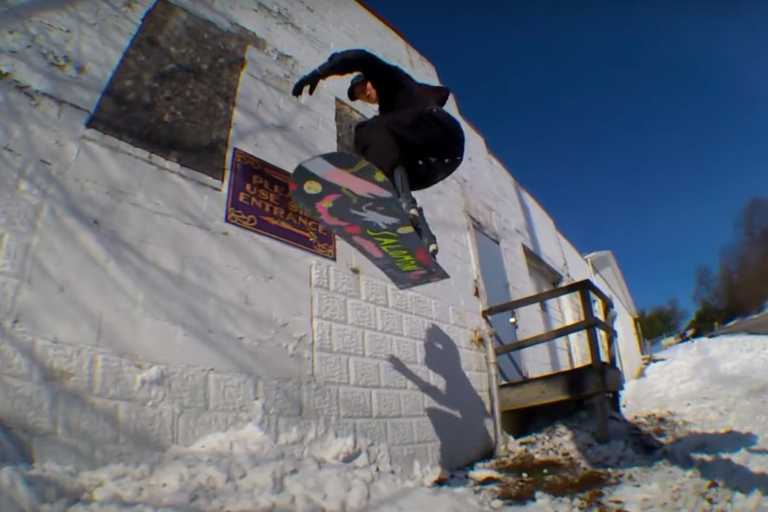Perspective: Elena Hight
First Descent of the east ridge of Mt. Bertha with Jeremy Jones and Griffin Post – Glacier Bay National Park, Alaska
Part 1 of Fear Feature from Snowboard Magazine issue 19.2.
My risk tolerance in the mountains is really pliable and based upon my personal preparation for that risk. If I feel prepared for a line, a trip, or an expedition, then, granted the conditions line up, I’m more willing to take on a bit more risk. I believe that proper preparation also helps mitigate a lot of fears that come up in high stress moments, or fears that you’re not expecting. Preparation helps one think clearly when those unexpected things that are bound to happen happen, and be able to act in a calm, collected way when the situation requires it.
It’s really easy to get excited about an idea, trip, or opportunity and put yourself in a situation where you are not prepared. In big mountains, especially in remote places, that’s really not an option because the risk is so high. We’re in these situations where if you are truly unprepared and unable to get yourself out of a position, the effects can be catastrophic, whether for yourself, the team, or the success of the trip.
This trip had been planned for quite a long time and had to be put off due to COVID. When I got the green light of that it was actually going to happen, I was beyond excited. I really I love being in the mountains with Jeremy and I always learn so much from him. The same with Griffin. My first thought when I was approached with this opportunity was, The crew is amazing, and it doesn’t really matter where we go or what we get into, we’re going to have an epic trip.
What draws me to this type of snowboarding, and adventure snowboarding in general, is pure curiosity of the unknown, this aspect of challenge in every form of the word, and pushing my own personal, perceived limits. That draw is often the very thing that scares the sh*t out of me at the same time. So that is the line that I walk: Am I capable of this challenge? Is the risk worth the reward? These are very personal questions when aiming to achieve big mountain goals. When the answer is yes, I do my own research and I am as prepared as possible stepping into those situations. That way, if I am on the side of a mountain and I’m like, Wow, I’m really, really scared, I can fall back on that. I prepared for this, I know what I’m doing, and really ground myself to be able to move through it.
Since retiring from halfpipe, I have dedicated all of my time and energy to this type of snowboarding. This was my fourth season with that focus and it was really perfect timing, because all of the skills and knowledge that I’ve accumulated were necessary and were put to use on this trip. In short, I felt prepared….
The walk in [to basecamp] was hard. I walk far and long and for many, many hours often in my everyday snowboarding, but a combination of so many factors made this an extra hard pursuit. It had snowed seven feet and the snow was pure, knee-high mud. It was the hardest snow I’ve ever walked in. Typically, a hike like that is far and it’s a big day, but this was nothing like we could have ever imagined when we stepped off the boat.
It’s a funny thing to wrap your head around, and its really easy to get in your head and let your mind play tricks on you. I think this is true in all parts of life, but in the mountains, you have to harness that energy and put it towards something. In this instance, honestly, with the incoming storm, we knew that this was our only chance to potentially make this trip happen at all—otherwise we were just headed back to the boat and calling it quits. The motivation to keep going and push through the fatigue and the mental boundaries and make it to camp was unwavering. It is incredible, when put in those types of scenarios, how strong your mind can be and how strong our bodies truly are.
Glaciers are crazy. They are so big and oftentimes, disorienting. Even though we had flown over the area in a plane and we’d seen a lot of Google maps and done a lot of research, there’s nothing like being on a massive glacier in Alaska and moving on your feet. You move so slow. You will be staring at the same mountain for eight hours and finally by the end of it be like, “Oh, wow. We’re actually making progress and getting past it.” It’s the wildest thing that your mind almost can’t even grasp.
During our walk, we ended up getting immersed in a cloud. It’s unlike when you’re snowboarding in a full vertigo scene, but you’re walking far and you’re working really hard with what feels like no reward. You have nothing to keep you going. No “Okay, once we reach this point, we’re going to be that much closer.” You’re just walking with no idea of how close or far, or if you’ve made any progress—you could be walking in circles.
When it’s finally go time, “Okay, this is the moment. Let’s try to accomplish what we came here for,” there’s just excitement and good energy. As you start to head up the mountain, before you hit any obstacles and you have to start assessing, for me, that moment is full of excitement, presence, and gratitude for being there and all of what it took to get to that point.

This was quite a big mountain. It was seven thousand feet from basecamp to the peak and because of the terrain, the snow conditions, and the glaciers protecting the mountain, we needed more time than just one morning to climb it. We decided to leave at night. One moment that stands out to me is as we got to our halfway mark, which is where we had a little bivy, we were hiking and it was pitch black. We had never been up that pitch before. It was the highest elevation we had been at on our trip up till that point. Jeremy likes to call it “boogeyman fear.” All of a sudden, all these fears surface because it’s dark and you can’t see anything and your mind wanders. You’re hiking the same mountain as you were before, but for whatever reason at nighttime, the Boogeyman comes out and starts to fill your head with all these crazy things. I experienced this firsthand. I don’t know, setting that bootpack and just being on this thin slice of the world in the pitch black—that was a moment for me where fear took over. It was crazy and testing, and challenged me in a really new way.
To move through it, there was this assessment of whether it was boogeyman fear or real fear: Is there something that I should be assessing and should actually be afraid of right now that could affect our team? For me, when it came down to it, it was just dark—I couldn’t really see the mountain and my mind began to wander. But we had been looking at this particular pitch for weeks; we knew exactly where we were. We knew the route up and we were pretty confident in our route and in our plan. I had to come back to the fact that I was prepared for this scenario and that there were no red flags, just boogeymen.
While I did feel afraid, I think that what attracts me to these challenges and keeps me coming back for more, is that idea of walking that line—the line between total exhilaration and excitement, and anxiety and unsureness—and being able to push through those boundaries that are in your head or your body and see what’s possible. The freedom that you feel on the other side of those moments, there’s nothing like it. And that’s what keeps snowboarders coming back for more, and keeps adventure athletes enthralled in what they’re doing.
They didn’t show it in the film, but we had hiked the pitch of this mountain and it was scary and hard and dark and all of the things. We set up our bivy, and right when we were about to go to sleep, the most amazing Northern Lights show came out. It was this crazy experience, where we felt we were looking straight at them rather than up because of the elevation we were perched at. We were looking horizontally at this amazing Northern Lights show. And then it just turned off and all of us were just awestruck. I believe when you push through these boundaries and these hard things, ultimately you get these glimpses into the world around you that you wouldn’t otherwise have. It is part of the magic that is hard to relay.
We called the last part of the ascent The Plank. I was just making sure every step that I took was really solid. Climbing up something super steep, being on the tips of your crampons and connected to the Earth in such a small way, it’ll take your breath away, for sure. At that point in the mountain, we were so close to the top, so there was a lot of excitement and adrenaline fueling this part of the climb.
In those really intense moments, I try to be really calm to be able to be connected to what I’m doing. I think that tapping into that is the gateway to success, right? That’s how you’re going to get through those moments. When the fears do creep in, or you look down or something happens that scares you, I really try to create a rhythm. Whether it’s when I’m hiking or when I’m snowboarding, if I’m in a really critical zone, I try to create a rhythm with my breath and with my movements. I find that really hones me in and helps me to block out the things that I’m seeing that might be scaring me and really just focus on something super simple and keep moving.
The summit was just pure joy. So much effort and a feeling of accomplishment and success. It’s hard to put into words. Just relief, too. “Okay, we finally made it.” There’s something really special about standing on top of a mountain because of the way being able to look out over the world makes you feel. For me, I feel super small and insignificant, and at the same time, very connected and in tune with all of the bigger surroundings. There’s also excitement for the team and the teamwork that it took to get there. Being able to share that experience with others is really special. All of those feelings all at once.
Being able to drop first was amazing. The very first pitch was actually somewhat mellow. I was just excited to get on my snowboard. I feel very in control on my snowboard. I am able to calm my mind and really tune into a flow state pretty easily, because I’ve been doing it for so long. And again, for me, when I get scared, or I know that there’s a really critical spot, I just try to create a rhythm with my turns and create a rhythm with my breathing and really hone in my focus on exactly where I want to be and how I want to be making those moves. And I tune out the fact that if I look just to the left, there’s a 5,000-foot drop or just to the right there are rocks for 500 feet into the unknown. The rhythm really keeps my eyes focused and I feel very confident in my snowboarding, as long as I can keep my headspace there. I can find that flow really well and that’s what I love about snowboarding. It’s one of the places that I can most easily access the present moment and really hone in. And I know that’s really special. There are so many distractions in life and having that access through snowboarding and the mountains is something I crave. It enhances life in so many ways.
That mountain was so fun. Fun and risk often go hand in hand for me—the constant balancing act. While we have dedicated our lives to snowboarding, accidents happen and there’s always an element of staying within your control because when things go wrong, they can go really wrong. I remember there being this point when my adrenaline faded and the exhaustion kicked in. That was the point when riding down the mountain where I took a deep breath and thought, Wow, my legs are tired. You forget how hard you’ve been working because your adrenaline’s pumping, and you’re just so excited and gripped and focused.
When you reach the bottom and get back to basecamp, it’s hard to describe those moments in words because it takes so much to successfully accomplish these types of objectives. There are so many elements and it takes such teamwork. You’re surrounded by all of these people who have helped make this dream a reality, and you’ve all worked so hard in your individual tasks to capture it and ride it and make sure it’s safe and all of the things. I think there’s this element of pride within the group, that we’re all really proud of ourselves and each other, and are exhausted, but so happy. I’m the most content as a human when my body is tired and my mind is free because I’ve been so focused on something, individually, for so long. I feel the most peaceful in the moments after something like that.
In general, I think that humans have a tendency to want to avoid fear and things that scare them. With this trip—or really any snowboarding expedition or objective— there’s so much personal power that comes through facing those fears and stepping out on the other side of them. It’s hard to describe, but it gives you, as a human, this power. I think it’s one of the greatest things in life, to be honest.
As told to Mary T. Walsh.
This story originally appeared in Fear Feature in issue 19.2.
Watch the expedition in episode 1 of Edge of the Earth.






